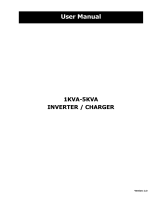
ABOUT THIS MANUAL
Purpose
This manual describes the assembly, installation, operation and troubleshooting of this unit. Please
read this manual carefully before installations and operations. Keep this manual for future reference.
Scope
This manual provides safety and installation guidelines as well as information on tools and wiring.
The following cases are not within the scope of warranty:
(1) Out of warranty.
(2) Series number was changed or lost.
(3) Battery capacity was declined or external damaged.
(4) Inverter was damaged caused of transport shift, remissness, ect external factor.
(5) Inverter was damaged caused of irresistible natural disasters.
(6) Not in accordance with the electrical power supply conditions or operate environment
caused damage.
SAFETY INSTRUCTIONS
WARNING: This chapter contains important safety and operating instructions.
Read and keep this manual for future reference.
1. Before using the unit, read all instructions and cautionary markings on the unit, the batteries
and all appropriate sections of this manual.
2. CAUTION --To reduce risk of injury, charge only deep-cycle lead acid type rechargeable batteries.
Other types of batteries may burst, causing personal injury and damage.
3. Do not disassemble the unit. Take it to a qualified service center when service or repair is required.
Incorrect re-assembly may result in a risk of electric shock or fire.
4. To reduce risk of electric shock, disconnect all wirings before attempting any maintenance or
cleaning. Turning off the unit will not reduce this risk.
5. CAUTION – Only qualified personnel can install this device with battery.
6. NEVER charge a frozen battery.
7. For optimum operation of this inverter/charger, please follow required spec to select appropriate
cable size. It’s very important to correctly operate this inverter/charger.
8. Be very cautious when working with metal tools on or around batteries. A potential risk exists
to drop a tool to spark or short circuit batteries or other electrical parts and could cause an
explosion.
9. Please strictly follow installation procedure when you want to disconnect AC or DC terminals.
Please refer to INSTALLATION section of this manual for the details.
10. Fuses (1 piece of 150A,63VDC for 1KW,4 pieces of 40A, 32VDC for 2KW and 6 pieces of 40A,
32VDC for 3KW) are provided as over-current protection for the battery supply.
11. GROUNDING INSTRUCTIONS -This inverter/charger should be connected to a permanent
grounded wiring system. Be sure to comply with local requirements and regulation to install
this inverter.
12. NEVER cause AC output and DC input short circuited. Do NOT connect to the mains when DC
input short circuits.
13. Warning!! Only qualified service persons are able to service this device. If errors still persist
after following troubleshooting table, please send this inverter/charger back to local dealer or
service center for maintenance.
-1-

























